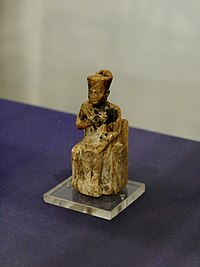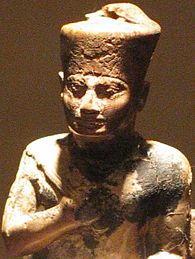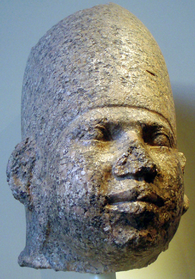Statuette of Cheops
| Statuette of Cheops | |
|---|---|
 Statuette of Cheops
|
|
| material | ivory |
| Dimensions | H. 7.5 cm; L. 2.9 cm; w. 2.6 cm; |
| origin | Abydos , Temple of Chontamenti |
| time | unsure |
| place | Cairo Egyptian Museum , JE 36143 |
The statuette of Cheops , also called the ivory figurine of Cheops or Cheops statuette , is a historically and archaeologically valuable artifact that was found in 1903 by Sir William Matthew Flinders Petrie during excavations in Kom el-Sultan near Abydos in Egypt . It represents the ancient Egyptian king ( Pharaoh ) Cheops of the 4th Dynasty ( Old Kingdom ).
The small seated figure is still the only three-dimensional representation of Cheops that has largely been preserved. There are also a large number of other statue fragments . The work of art is classified as contemporary by the majority of Egyptologists and therefore most likely dates from the reign of Cheops. However, due to the unusual location, the chronological classification has also been questioned several times. The Egyptologist Zahi Hawass completely doubts the dating to the Old Kingdom. His thoughts on assigning it to the 26th dynasty have so far received little response, but have not yet been refuted. The ritual purpose of the statuette is also unclear. If it is contemporary, it was either part of the traditional statue cult or the cult of the dead . If, on the other hand, the figurine is from a later period, it may have served as a votive offering , as suggested by Hawass . Your artist is unknown.
description
The ivory figure is about 7.5 cm high, 2.9 cm long and about 2.6 cm wide and partially damaged. Its surface was originally smooth and shiny. The statuette shows Cheops with the red crown of Lower Egypt . The king sits on a largely unadorned throne with a low backrest. In his right hand, which he raises at chest level, he holds a flagellum , the end of which rests on the right shoulder, the frond rests on the upper arm. The left arm is bent, the forearm rests entirely on the left leg. The left hand is open, the palm of the hand resting on the left knee. The feet and the pedestal have broken off. The red crown is damaged, both the high bridge and the decorative spiral have broken off. The head is slightly disproportionate compared to the body of the seated figure , the ears are slightly protruding. The chin is angular and the figure did not have a ceremonial beard . The king wears a short and pleated apron , his upper body is bare. On the right side of Cheops knees the name of Horus Medjedu is preserved, on the left side of the knees the very short remainder of the lower part of the personal name is visible in cartouche as Khnum-Chuf .
Find history
Location
The artefact was 1903 by Petrie in the abydenischen Grabungsstätte Kom el-Sultan in any one of a " magazine C described" spaces of large, highly decayed temple god of the dead Osiris - Chontamenti (in the excavation plans as a building K recorded) in southern excavation sector found. The temple of Kom el-Sultan was consecrated to the jackal-headed god Chontamenti from the earliest times to around the middle of the 3rd dynasty ; in the Middle Kingdom a sanctuary was built in honor of the mummy-shaped god Osiris. The gods Chontamenti and Osiris soon merged and the temple complex was now regarded as the "Sanctuary of Osiris-Chontamenti". In said room of the magazine C there were still stucco remains of other wooden statues from the same period.
Finding circumstances
The Cheops figure was initially headless, Petrie attributes this damage to an accident during the excavation work. When Petrie realized the importance of the find, he stopped all work and awarded a reward to whoever could find the head. Three weeks later, after intensive sifting , the head was found under the rubble. Today the restored small statue is exhibited in the Egyptian Museum in Cairo in room 32 with the inventory number JE 36143 .
The circumstances in which the Cheops figurine was found are perceived by some Egyptologists as "unusual" to "contradicting". Zahi Hawass in particular uses the circumstances of the find as the main argument for his doubts about the dating of the figurine. He justifies this with the fact that no building that is definitely from the 4th Dynasty has ever been excavated in Kom el-Sultan or Abydos. Strictly speaking, Petrie is only convinced, based on the finding of the Cheops figurine, that room “C” must also have been part of a temple or shrine of the 4th dynasty. But building “K” (along with the magazines) has meanwhile turned out to be part of a building complex of the 6th dynasty . A large number of objects from the 1st , 2nd , 6th and 30th dynasties were found in the temple of Chontamenti , but none that can be reliably dated to the 4th dynasty. Thus, the temple does not appear to have been used during this period. Even Petrie was unable to find any evidence of a building from the time of the Cheops dynasty during his excavations, but he explained this with a reference to the Greek historians Herodotus and Diodor , who report that Cheops had the erection of temples and shrines during his reign forbidden. Richard Bussmann recently referred to an unpublished limestone fragment with the name of Cheops from Abydos, which at least seems to be evidence of the ruler's building activities in Abydos. He therefore wonders whether building K could have been a temple for the cult of Cheops.
Dating
The majority of Egyptologists assign the statuette to the Old Kingdom, i.e. the time of Cheops. So Petrie was already sure that the figure must come from the 4th dynasty. The main argument for dating to the 4th dynasty is the naming of Cheops. Furthermore, the stylistics of the statuette are used and compared with works of art from the same era and those from earlier dynasties . Rainer Stadelmann points out the figurine's throne seat, which is probably modeled on the cube-shaped royal seats with a short backrest from the predynastic era. Barry J. Kemp and William S. Smith point out that the execution of the face of the Cheops figure most closely resembles that of the statues from the time of the kings Chasechemui , Djoser and Sneferu . The faces of Chasechemui and Snofru are also beardless and the facial expression of Cheops seems to be modeled on that of Djoser on his limestone statue. Especially the broad nose, the rounded face and the rather modestly worked out eyebrows are clearly based on the art style of the 3rd dynasty. The slightly protruding ears are reminiscent of those of the statues of Chasechemui. With this facial composition, the portrait of Cheops represents a transitional form from the archaic art style to the actual style of the Old Kingdom. This art style can no longer be proven in any king after Djedefre , from King Chephren the portrayal of kings with ceremonial beards prevails . The artistic elaboration of the ivory figure is consistently rated as "masterful" and "professional" by the researchers. It is the earliest known Egyptian sculpture showing a king with a red crown. However, this is already occupied under Chephren.
Zahi Hawass, however, doubts that the statuette was made at that time. He finds Petrie's dating method unreliable due to the circumstances of the find and points out that the face of Cheops is unusually stocky and chubby and does not show any emotional expression. In contrast to Petrie and Margaret Alice Murray , who described the figurine's face as “powerful” and “terrifying” (which is why it fits so well with Greek traditions), Hawass feels reminded of the face of a very young, possibly underage person . Hawass compared the facial stylistics with the statues of other, contemporary kings such as Sneferu , Chephren and Mykerinos . The faces of these three kings are of even beauty, slim and with a friendly expression - they are based on an ideal of beauty that deliberately does not correspond to reality . Hawass was particularly interested in an ivory statuette of King Mykerinos, which is exhibited today in the Boston Museum under the inventory number Boston 11.280ab . Although headless to this day, the figure shows the same posture as the Cheops figurine, but its body is much slimmer and more athletic and the work of art is worked out much more carefully. Instead, the appearance of Cheops on the ivory statue seems rather as if the artist had not placed great emphasis on professionalism and artistic care. Cheops himself would never have allowed such a comparatively inferior artifact to be placed in his palace or anywhere else. And finally, argues Hawass, the design of the throne on which the figure sits does not match the artistic counterparts of the Old Kingdom: In the Old Kingdom, the back of a royal throne reached down to the ruler's neck. A final proof that the statue must be a reproduction from a much later time is for Hawass the so-called Nehenech - flail in the left hand of Cheops. Round plastic representations of a king with such a flail as a ceremonial insignium do not appear before the Middle Kingdom. Zahi Hawass therefore concludes that the figure may have been sold as an amulet or talisman to pious citizens and tourists during the 26th Dynasty (or later) . The presence of the figurine at the place where it was found could therefore be explained by its functional role as a votive offering .
Ultimately, Zahi Hawass is convinced that the Cheops statuette is most likely a replica of a life-size or larger-than-life statue. Presumably, the original was in Memphis, Lower Egypt, which would explain why Cheops wears the red crown on his figurine. This would also support a dating to the 26th Dynasty: At this time, homages to the Old Kingdom were very popular, old and forgotten deities were portrayed in reliefs and statues, and king statues were made as miniatures and sold as good luck charms or votive offerings. Even old, forgotten or discarded rank titles of the Old Kingdom were taken up again and awarded to high officials . From the temple ruins of King Taharqa , scenes have been preserved in relief, the pictorial program of which is clearly modeled on various murals from the Old Kingdom. Finally, Hawass thinks that the face of the Cheops statuette most closely resembles the black granite heads of Taharqa. Hawass, citing the work of Wiliam S. Smith, points out that figurines of kings of the Old Kingdom were mass- produced during the late period , this probably also applies to the Cheops figure and the rather negligent design of the statuette is therefore not surprising .
Art historical importance
The figurine is the only round three-dimensional artifact that completely portrays Cheops . It is often said that the small ivory figure is the only surviving statue of Cheops. In fact, however, several alabaster fragments of seated statues have been preserved that were found by George Andrew Reisner during his excavations in Giza . Overall, Rainer Stadelmann estimates the original number of Cheops statues, which must have once stood alone in the mortuary temple, at around 50. A number of 21-25 statues is assumed for the heir to the throne Djedefre. On the bases of the Cheops statues, the complete royal statute of the ruler was engraved; today the names are only preserved in fragments, but still allow a safe assignment. The full and shortened form of the name of Cheops (namely "Chufu" and "Khnum-chuf (u)") were used equally often. One of the fragments, from a small seated statue, still shows the feet of a seated king from her ankles down. To the right of her toes, the name syllable … fu is preserved in a cartouche, it can easily be reconstructed to the cartouche name Chufu .
The Palermostein reports on its fragment C-2 about the creation of two oversized statues for the king, one is said to have been made of copper , the other made of pure gold .
In addition, several heads of statues have been preserved, some of which are attributed to Cheops due to their facial style. The best known among them are the " Brooklyn King's Head" made of rose granite and the so-called "Munich King's Head" made of limestone. Both heads show the ruler with the white crown of Upper Egypt .
The front part of a ram statue made of polished basalt , whose base shows the name of Horus and the cartouche of Cheops, is unusual .
literature
- Zahi Hawass : The Khufu Statuette: Is it an Old Kingdom Sculpture? In: Paule Posener-Kriéger (Ed.): Mélanges Gamal Eddin Mokhtar (= Bibliothèque d'étude. Volume 97, No. 1). Institut français d'archéologie orientale du Caire, Cairo 1985, ISBN 2-7247-0020-1 .
- WM Flinders Petrie : Abydos Part II. The Egypt Exploration Fund, London 1903, ( online version ).
- Abeer El-Shahawy, Farid S. Atiya: The Egyptian Museum in Cairo. A Walk Through the Alleys of Ancient Egypt . American University in Cairo Press, New York / Cairo 2005, ISBN 9771721836 .
- William Stevenson Smith, William Kelly Simpson: The Art and Architecture of Ancient Egypt (= Pelican history of art , Volume 14). 3rd Edition, Yale University Press, New Haven 1998, ISBN 0300077475 .
- The main works in the Egyptian Museum in Cairo. Official catalog. Published by the Antiquities Service of the Arab Republic of Egypt. von Zabern, Mainz 1986, ISBN 3-8053-0640-7 ; ISBN 3-8053-0904-X , No. 28.
Individual evidence
- ↑ a b c d e f g W. M. Flinders Petrie: Abydos II. London 1903, p. 30; Panel XIII and Panel XIV.
- ↑ a b c d e f g h i j k Zahi Hawass: The Khufu Statuette. Cairo 1985, pp. 379-394.
- ↑ a b c d e Abeer El-Shahawy, Farid S. Atiya: The Egyptian Museum in Cairo. P. 49ff.
- ↑ a b c d e f Barry J. Kemp: The Osiris Temple at Abydos . In: Communications from the German Archaeological Institute, Cairo Department. (MDAIK) No. 23, 1968, pp. 138-155.
- ^ Richard Bussmann: The provincial temples of Egypt from the 0th to the 11th dynasty (= Problems of Egyptology , Volume 30). Brill, Leiden 2007, ISBN 9789004179332 , pp. 90, 147, 467.
- ^ Margaret Alice Murray: Egyptian sculpture . New edition, Greenwood Press, London 1970, pp. 50-52.
- ↑ a b Rainer Stadelmann: Formal criteria for dating the royal sculpture of the 4th dynasty . In: Nicolas Grimal : Les critères de datation stylistiques à l'Ancien Empire . Institut français d'archéologie orientale, Le Caire 1998, ISBN 2-7247-0206-9 , p. 353.
- ↑ a b c Wiliam S. Smith: A History of Egyptian Sculpture and Painting in the Old Kingdom . Pp. 20 & 157.
- ↑ Krzysztof Grymski: Royal Statuary . In: John P. O'Neill (editor): Egyptian Art in the Age of te Pyramids . Metropolitan Museum of Art, New York 1999, ISBN 0-87099-906-0 , p. 54.
- ^ Christian Ziegler: Small Head of King Khafre with Red Crown . In: John P. O'Neill (editor): Egyptian Art in the Age of te Pyramids . Metropolitan Museum of Art, New York 1999, ISBN 0-87099-906-0 , p. 260.
- ^ Wiliam S. Smith: A History of Egyptian Sculpture and Painting in the Old Kingdom . Geoffrey Cumberledge, London 1949, pp. 398-405.
- ↑ Dagmar Stockfisch: Investigations into the cult of the dead of the Egyptian king in the Old Kingdom. The decoration of the royal cult complexes (= Antiquitates , Volume 25.). Kovač, Hamburg 1994, ISBN 3-8300-0857-0 , pp. 19 & 93.
- ^ Thomas Schneider : Lexicon of the Pharaohs . Albatros, Düsseldorf 2002, ISBN 3-491-96053-3 , pp. 100-102.
- ^ Richard A. Fazzini, Robert S. Bianchi, James F. Romano, Donald B. Spanel: Ancient Egyptian Art in the Brooklyn Museum . Brooklyn Museum, Brooklyn (NY) 1989, ISBN 0-87273-118-9 , p. 31.
- ↑ Sylvia Schoske, Dietrich Wildung (ed.): State Collection of Egyptian Art Munich (= Zabern's illustrated books on archeology. Volume 31). von Zabern, Mainz 1995, ISBN 3-8053-1837-5 , p. 43.

